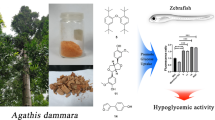Summary
Limonene has been shown to be an effective, nontoxic chemopreventive and chemotherapeutic agent in chemically induced rat mammary-cancer models. The present study characterized circulating metabolites of limonene in female rats and determined their effects on cell growth. Metabolism of limonene was analyzed in plasma extracts by gas chromatography. Rapid conversion of limonene to two major metabolites was detected. These metabolites comprised more than 80% of the circulating limonene-derived material at 1 h after administration and thereafter, whereas limonene itself accounted for only 15%. The metabolites were characterized by mass spectroscopy and infrared spectroscopy. The probable structures were synthesized, and identities were confirmed by comparison of retention times and mass spectra. The two major circulating metabolites of limonene were found to be perillic acid and dihydroperillic acid. We have previously reported that limonene, perillic acid, and dihydroperillic acid inhibit the posttranslational isoprenylation of p21ras and other 21- to 26-kDa cell-growth-associated proteins in NIH3T3 cells and in mammary epithelial cells. In the present study, perillic acid was found to inhibit cell growth in a dose-dependent manner. Thus, perillic acid and dihydroperillic acid, the two major circulating metabolites of limonene in the rat, are more potent inhibitors of protein isoprenylation than is limonene, and perillic acid is also a more potent inhibitor of cell growth. These data raise the possibility that the antitumor effects of limonene in vivo may be mediated via perillic acid and, perhaps, other metabolites.
Similar content being viewed by others
References
Bal BS, Childers WE, Pinnick HW (1981) Oxidation of α,β-unsaturated aldehydes. Tetrahedron 37: 2091
Caine D (1976) Reduction and related reactions of α,β-unsaturated carbonyl compounds with metals in liquid ammonia. Org React 23: 1
Crowell PL, Chang RR, Ren Z, Elson CE, Gould MN (1991) Selective inhibition of isoprenylation of 21–26 kDa proteins by the anticarcinogend-limonene and its metabolites. J Biol Chem 266: 17679
Crowell PL, Kennan WS, Haag JD, Ahmad S, Vedejs E, Gould MN (1992) Chemoprevention of mammary carcinogenesis by hydroxylated derivatives of limonene. Carcinogenesis 13 (in press)
Dhavalikar RS, Bhattacharyya PK (1966) Microbiological transformation of terpenes: VIII. Fermentation of limonene by a soil pseudomonad. Indian J Biochem 3: 144
Elegbede JA, Elson CE, Qureshi A, Tanner MA, Gould MN (1984) Inhibition of DMBA-induced mammary cancer by the monoterpened-limonene. Carcinogenesis 5: 661
Elegbede JA, Elson CE, Tanner MA, Qureshi A, Gould MN (1986) Regression of rat primary mammary tumours following dietaryd-limonene. J Natl Cancer Inst 76: 323
Elson CE, Maltzman TH, Boston JL, Tanner MA, Gould MN (1988) Anti-carcinogenic activity ofd-limonene during the initiation and promotion/progression stages of DMBA-induced rat mammary carcinogenesis. Carcinogenesis 9: 331
Haag JD, Lindstrom MJ, Gould MN (1992) Limonene-induced regression of mammary carcinomas. Cancer Res 52: 4021
Hortmann AG, Ong AQ (1970) A new route to 8- and 9-substitutedcarenes. J Org Chem 35: 4290
Igimi H, Nishimura M, Kodama R, Ide H (1974) Studies on the metabolism ofd-limonene (p-mentha-1,8-diene): I. The absorption, distribution and excretion ofd-limonene in rats. Xenobiotica 4: 7
Jackson JH, Cochrane CG, Bourne JR, Solski PA, Buss JE, Der CJ (1990) Farnesol modification of Kirsten-ras-exon 4B protein is essential for transformation. Proc Natl Acad Sci USA 87: 3042
Kodama R, Yano T, Furukawa K, Noda K, Ide H (1976) Studies on the metabolism ofd-limonene (p-mentha-1,8-diene): IV. Isolation and characterization of new metabolites and species differences in metabolism. Xenobiotica 6: 377
Maltzman TH, Hurt LM, Elson CE, Tanner MA, Gould MN (1989) The prevention of nitrosomethylurea-induced mammary tumors byd-limonene and orange oil. Carcinogenesis 10: 781
McClean SW, Ruddel ME, Gross EG, DeGiovanna JJ, Peck GL (1982) Liquidchromatographic assay for retinol (vitamin A) and retinol analogs in therapeutic trials. Clin Chem 28: 693
Regan JW, Morris MM, Nao B, Bjeldanes LF (1980) Metabolism of limonene-1,2-epoxide in the rat. Xenobiotica 10:859
Silverstein RM, Bassler GC, Morrill TC (1991) Infrared spectrometry. In: Sawicki D, Steifel J (eds) Spectrometric identification of organic compounds, 5th edn. John Wiley and Sons, New York, p 91
Silverstein RM, Bassler GC, Morrill TC (1991) Mass spectrometry. In: Sawicki D, Steifel J (eds) Spectrometric identification of organic compounds, 5th edn. John Wiley and Sons, New York, p 3
Watabe T, Hiratsuka A, Ozawa N, Isobe M (1981) A comparative study on the metabolism ofd-limonene and 4-vinylcyclohex-1-ene by hepatic microsomes. Xenobiotica 11:333
Wattenberg LW (1983) Inhibition of neoplasia by minor dietary constituents. Cancer Res 43: 2448
Wattenberg LW (1989) Inhibition ofN-nitrosodiethylamine carcinogenesis in mice by naturally occurring organosulfur compounds and monoterpenes. Cancer Res 49: 2689
Wattenberg LW, Coccia JB (1991) Inhibition of 4-(methylnitrosamino)-1-(3-pyridyl)-1-butanone carcinogenesis in mice byd-limonene and citrus fruit oils. Carcinogenesis 12: 115
Welch SC, Chou CY, Gruber JM, Assercq JM (1985) Total syntheses of (±)-seychellene, (±)-isocycloseychellene, and (±)-isoseychellene. J Org Chem 50: 2668
Author information
Authors and Affiliations
Additional information
This work was supported by NIH, PHS grant CA 38 128 and in part by NIH training grant 5T32CA 09471 (to P. L. C.)
Rights and permissions
About this article
Cite this article
Crowell, P.L., Lin, S., Vedejs, E. et al. Identification of metabolites of the antitumor agentd-limonene capable of inhibiting protein isoprenylation and cell growth. Cancer Chemother. Pharmacol. 31, 205–212 (1992). https://doi.org/10.1007/BF00685549
Received:
Issue Date:
DOI: https://doi.org/10.1007/BF00685549




